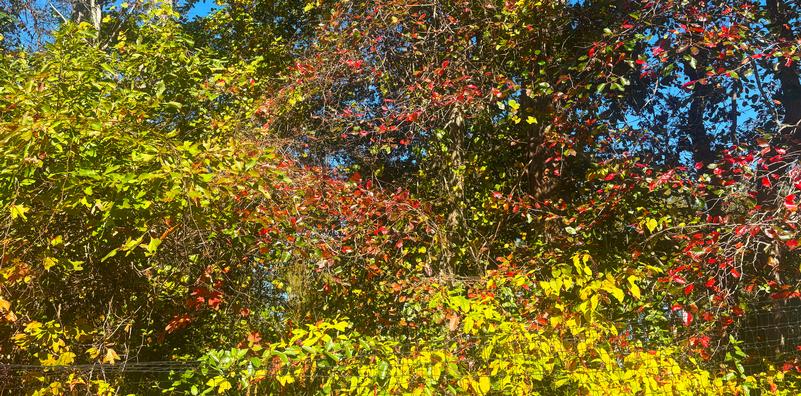Shade Tree Season
With the advent of cooler weather and the forever-disorienting shorter daylight hours (I don’t know about you, but waking up well before the sun has never been my thing), the woodlands surrounding Pleasant Run have finally begun their autumnal transition en masse. You may remember when we highlighted the scarlet foliage of early transitioner Nyssa sylvatica a couple of weeks ago, delighting in a massive 40’ specimen found along the nursery periphery.
As it turns out, black tupelo trees are somewhat of a trendsetter for their forest companions: maples, birches, sassafrases, black walnuts, honey locusts, and dogwoods follow suit, with stubborn stragglers like the oaks retaining their green foliage until the last possible moment before turning color and finally bequeathing them to the forest floor below.
Just in time for this seasonal spectacle, we seem to be inundated with tree education and awareness programs. This week alone we attended the New Jersey Shade Tree Federation’s 100th Anniversary Conference and Morris Arboretum’s Tree Canopy Conference, with Ambler Arboretum at Temple University’s annual Ambler in Bloom event at the beginning of the month featuring the theme “The Stories Our Trees Tell”.
Across these organizations and institutions made up of educators, students, architects, designers, contractors, and concerned ecologists, there appears to be one major concern:
“Which of our native trees are built for withstanding increasingly difficult weather patterns and environmental factors?”
We spoke a couple weeks ago about Nyssa sylvatica’s near apathy to having wet feet after discovering our own wild community of black tupelos happily indulging in pond and streamside real estate around the nursery perimeter, securing its spot as a flood tolerant selection for sites facing rising water tables.
Luckily, there are many steadfast and sturdy native tree selections that seemingly laugh in the face of environmental adversity.
We’ve compiled a few lists of these apt selections for easy reference: View the attachments below.
Fall is the Best Time for Planting!
Check out our availability & add some of these tried-and-true tree selections to your next order for a whole extra growing season before spring showtime!
References:
Arbor Day Foundation. (2019, July 17). 9 trees that can survive flooding | arbor day foundation. https://www.arborday.org/perspectives/9-trees-can-survive-flooding
Caldwell, C. (2021). Trees that can handle heat and drought. Piedmont Master Gardeners. https://piedmontmastergardeners.org/article/trees-that-can-handle-heat-and-drought/
Division of Lands and Forests. (2018, January 29). Native Flowers, Grasses, Shrubs, Trees, and Vines. Albany; New York State Department of Environmental Conservation.
Nolan, J. (2023, December 10). 18 Native Texas Trees (With Pictures) - Identification Guide. Leafy Place. https://leafyplace.com/native-texas-trees/


